What you need to know
In the first of a 5 part series, Justin Hugo looks at how statistics suggesting the Asian Tiger economies have caught up with their Scandinavian counterparts mask a more sobering wage-based reality.
Wage wars
The Asian Tigers and Japan have enjoyed a remarkable growth streak over the last half a decade that has put them firmly in the league of high-income countries – at least as measured by GDP per capita – a phenomenon bested by only some oil-rich Gulf states.
But in terms of the actual livelihoods of their citizens, have they caught up?
Nordic countries are upheld as the gold standard of what a model country should look like, often featuring in lists of the world’s best places to live with the happiest people in the world. How would the Asian Tigers – known on the contrary for their high stress levels and rates of suicide – compare with the Nordics, and with the Netherlands, which Taipei mayor Ko Wen-je (柯文哲) said is “an excellent model [… and] the best country for Taipei to learn from,” having realized that Taiwan's thriving democracy discounts emulating the region’s leading economic light, Singapore.
“[Former] President Lee Teng-hui (李登輝) had led Taiwan along a “democratic path,” that meant [that Taiwan] could never be like Singapore,” Ko reportedly said. Taiwan and the Netherlands also have significant historical links dating back to when Taiwan was a Dutch colony (1624-1662), the Taipei mayor added.
But the growth spurt among the Asian Tigers did not happen all at once. Back in 1950, the real GDP per capita of Hong Kong, Japan and Singapore was already among the highest in Asia, at US$4,013, US$2,519 and US$2,439, respectively. Taiwan’s real GDP per capita was US$1,393 and South Korea’s US$1,122, according to data from the University of Groningen’s Maddison Project Database, which provides researchers with tools to compare economic performance between regions.
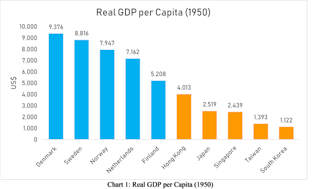
Meanwhile, the real GDP per capita of the Nordics and the Netherlands was twice at high, at between US$5,208 (Finland) and US$9,376 (Denmark) – they were already one of the richest countries in the world at that time.
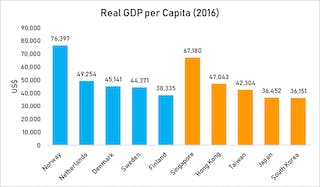
Nearly 70 years later, in 2016, Norway’s real GDP per capita had grown to US$76,397 while Singapore’s had shot past the rest of the pack to US$67,180.
At the same time, Hong Kong’s real GDP per capita had grown to US$47,043, similar to the Netherlands’ US$49,254 and Denmark’s US$45,141, Taiwan’s had risen to US$42,304 which is comparable with Sweden’s US$44,371. Japan and South Korea real GDP per capita were roughly on par with Finland’s US$38,335.
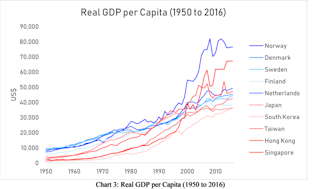
One might assume that a similar level of national wealth might equate to citizens enjoying a similarly high standard of living, but this is where the GDP per capita statistics are misleading.
A more illuminating comparison involves looking at the minimum and median wages of each country.

Source (data from latest year): Norway: Norwegian Labour Inspection Authority, Denmark: 3F - Danmarks Stærkeste Fagforening, Sweden: Swedish Work Environment Authority, Finland: Service Union United PAM, Netherlands: Government of the Netherlands, Japan: Japan International Labour Foundation, South Korea: Pulsenews.co.kr (Maeil Business Newspaper’s English news site), Taiwan: Ministry of Labor Republic of China (Taiwan), Hong Kong: Labour Department The Government of the Hong Kong Special Administrative Region, Singapore: Ministry of Manpower Singapore.
In the Nordics, there are no minimum wages – salaries are collectively bargained for by labor unions in different industrial sectors – which by the way, results in the highest wages in the world. According to the International Labour Organisation (ILO), collective agreements cover about 90 percent of workers in Finland, 89 percent in Sweden, 84 percent in Denmark and 67 percent in Norway.
For the purposes of this comparison, we can use the wages of transport workers as the de facto minimum wages in the Nordics: Norwegians earn a monthly minimum of approximately 27,662.25 krone (US$3,517), the Swedes 25,088.00 krona (US$3,107) and the Finns €2,080 (US$2,542). For the Danes, workers in the industrial sector earn a minimum of 18,502.22 krone (US$3,039). In the Netherlands, where there is a nationally legislated minimum wage, it is €1,578.00 (US$1,929).
Turning to East Asia, Japan has the most respectable monthly minimum wage, at about 168,608 yen (US$1,524). South Korea’s historic minimum wage increase to 1,573,770 won (US$1,475) last year is also palatable.
So far, the minimum wages of these countries correspond roughly to their nominal GDP per capita, where the higher the nominal GDP per capita, the higher the minimum wage.
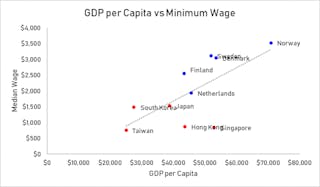
Denmark, Sweden and Finland generally perform better by having minimum wages that are higher than the regression line, and the minimum wage increase that South Korea implemented last year elevated its position to a similarly lofty level.
Taiwan’s minimum wage of NT$22,008 (US$749) that took effect at the start of this year still leaves the country lagging below the regression line.
There are two other distinct outliers – Singapore and Hong Kong. Even though they have higher nominal GDP per capita than Taiwan, their minimum wage is set at a similarly depressed level – Singapore’s de facto monthly minimum wage is SG$1,100 (US$833) and Hong Kong’s is HK$6,724.74 (US$860).
In fact, Singapore does not have a minimum wage – basic minimum wages are set for the cleaning, landscape and security sectors but unlike the Nordics, the "minimum wages" set for these sectors are low – basic minimum wages for security officers are used for this comparison. According to Singapore’s Ministry of Manpower, these "minimum wages" are “developed by tripartite committees consisting of unions, employers and the government.”
However, it should be noted that the government has its hands in the unions and businesses, which precipitates something more like a “one-partite” arrangement. The confederation of trade unions in the country – the National Trades Union Congress (NTUC) – is headed by a minister – Chan Chun Sing – who is widely tipped to be Singapore’s next prime minister. There is also high state control of publicly traded companies in Singapore – 23.6 percent as compared to only 1.1 percent, 3.0 percent, 3.7 percent and 5.1 percent in Japan, Taiwan, Hong Kong and South Korea, respectively – though the figure for Taiwan is higher if you include companies indirectly controlled by state-owned shareholders.
Singapore’s nominal GDP per capita of US$52,963 is two times higher than Taiwan’s and puts it in between Denmark and Sweden. If Singapore were to adopt a similar minimum wage, it would be at least US$3,000 (SG$3,963) – or around US$2,300 (SG$3,039) if following the regression line above. Similarly, Hong Kong’s minimum wage should be closer to US$1,850 (HK$14,459) – on a par with the Netherlands, which has a similar level of nominal GDP per capita.
As such, low-income workers in Singapore and Hong Kong are being short-changed.
But the minimum wage does not give an overall perspective of the wage situation in these countries, so we also need to address median wages.

Norway has the highest monthly median wage (€4,562.37 / US$5,576) among the Nordics and the median wage in the Netherlands is €2,672 (US$3,226).
Japan has the highest median wage among the East Asian countries, of an estimated US$2,711, while Taiwan (NT$40,612 / US$1,382) has the lowest. South Korea’s (2,017,692.31 won / US$1,891) median wage is second-lowest.
As you can also see from the below, the higher the nominal GDP per capita, the higher the median wage as well.
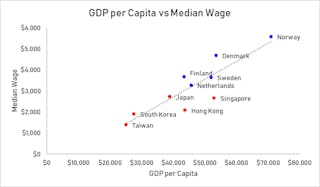
Denmark (€ 3,828 / US$4,679) and Finland (€3,001 / US$3,668) have the second- and third- highest median wages in the Nordics and also sit above the regression line.
On the other hand, for Singapore and Hong Kong, median wages are considerably lower than trend. If median wages were to follow the regression line, Singapore’s should be closer to US$3,800 (S$5,020) and that of Hong Kong should be nearer to US$3,000 (HK$23,448), instead of the current S$3,500 (US$2,649) and HK$16,200 (US$2,073), respectively. In other words, the citizens of both cities should be earning a median wage of about US$1,000 more.
Whys and wages shares
What accounts for the discrepancy between wages and the GDP per capita in Singapore? If Singapore is considered one of the richest places in the world, why would its (de facto) minimum wages be among the lowest in high-income countries?
To see why, let’s look at the wage share of each country – or the share of GDP that goes to wages.

We saw that Denmark, Sweden and Finland had de facto minimum wages that were higher than the regression line. One reason for this is their relatively higher wage shares – of 63.4 percent, 62.1 percent and 62.0 percent.
At the other end of the scale, Singapore’s wage share of only 42.5 percent explains why its de facto minimum wage is lower than the regression line.
Of note, too, is that Taiwan’s wage share is also low – at only 44 percent. As such, similar to Singaporeans, Taiwanese are not being compensated fairly for their labor, at least compared with high-income peers.
If the Taiwanese were paid a wage share of 50 percent – closer to the workers of South Korea (wage share of 51.8 percent) and Hong Kong (50 percent), then it follows by a back-of-an-envelope calculation that the minimum wage would also fall in line with theirs at about NT$25,000 (US$851). By the same logic, if wage share was elevated to the 60 percent level of Denmark, Sweden and Finland, then Taiwan’s minimum wage would amount to NT$30,000 (US$1,021)
Moreover, Chang Wen-po (張溫波), a former professor at National Taiwan University and retired department director at the Economic Development Council has shown in a Taipei Times article that when dividing Taiwan's nominal GDP per capita last year by current wage share, the amount of NT$26,974 is actually lower than the NT$30,792 you would have obtained in the late 1980s and early 90s, when wage share was half of GDP. “[NT$30,792] would probably be acceptable for low-income earners [as a minimum wage],” he concluded.
Of course, a minimum wage of NT$30,000 (US$1,021) is “a dream” according to Taiwan President Tsai Ing-wen (蔡英文), who in a television interview recently declined to set out a timetable for when that dream might come true. Still, the fact that the figure is on the table is a step in the right direction.
Similarly, if Singapore’s wage share were to increase to 50-60 percent, minimum wages should correspondingly rise to between SG$1,230 (US$931) and SG$1,550 (US$1,173) – just a touch higher than in Taiwan under the same framework. But as explained previously, Singapore’s minimum wage should range between US$2,300 and US$3,000.
In part 2, we'll look more closely at how corporate cronyism drives inequality and underpins the wage differentials outlined above.
In part 2: Inequality, poverty and corporate culture
Editor: David Green



